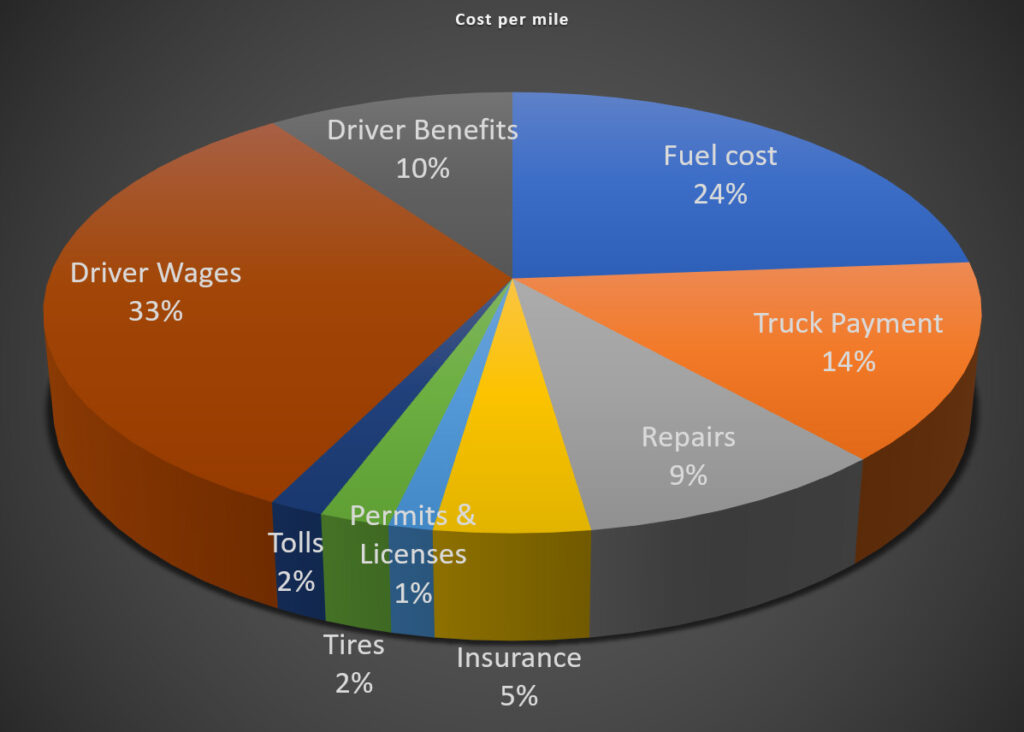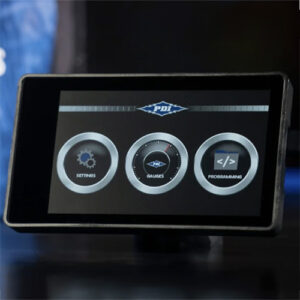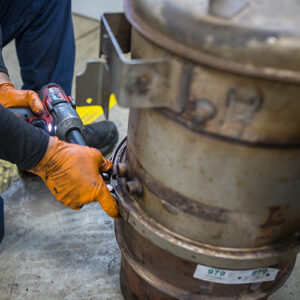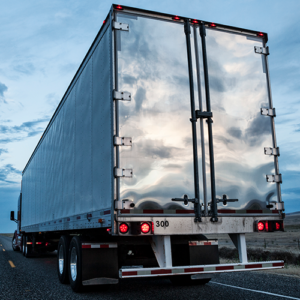The Real Cost Of Trucking & How To Reduce Your Costs
Truck driving is more than just a job – it’s your livelihood. But the costs involved in hauling freight across the country can add up quickly, draining profits and leaving you with barely enough for fuel, let alone any time off the road.
Determining the exact cost of trucking is essential to making an accurate budget and staying solvent as a driver or operator.
In this post, we’ll explore what goes into calculating these expenses – from vehicle maintenance to taxes and beyond – so you can plan accordingly and keep your business afloat!
Why did I have that coffee?

Truck Drivers, on average, spend over $600 per year on coffee or $.004 per mile.
With 3.6 million Truck Drivers in the US that gives an impressive $2,160,000,000 spent on coffee to keep trucks moving!
While the Coffee numbers are fun, however you want to know what your cost should be to run a truck.
Lets start with industry statistics based on what fleets spent
Average truck operating costs as Cost Per Mile Percent of cost for operating a truck:

| Cost Per Mile | Percent of cost | |
| Fuel | $.40 | 23.8% |
| Truck Payments | $.24 | 14.6% |
| Repairs | $.16 | 9.4% |
| Insurance | $.08 | 4.6% |
| Permits and License | $.02 | 1.3% |
| Tires | $.04 | 2.1% |
| Tolls | $.03 | 1.6% |
| Drivers Wages | $.55 | 32.7% |
| Driver Benefits | $.17 | 9.9% |
Start By Combining Truck Payments and Repairs To Maximize Savings
Maximize your savings by streamlining your truck expenses. Instead of separating your truck payment and repairs, consider combining them to optimize your budget.
If you own a used truck or have paid off your loan, industry-standard percentages may not apply to you.
Allocate 24% for both truck payments and repairs. Any surplus from your payment allocation can be saved in a dedicated account to cover future repairs or vehicle replacement.
This smart approach ensures that you have easy access to funds when you need them the most.
Preventive maintenance will save you money
Whether you’re just starting out as a truck driver or an owner-operator with years of experience, preventive maintenance is the key to keeping your trucks in top condition, reducing repair and maintenance costs.
The last thing any business needs is a sudden breakdown that can incur costly repair bills and a lengthy shutdown.
Taking time to stay proactive with preventive maintenance for your fleet will reduce your cost of trucking in the long run, not only on diagnoses and repairs but also in preventing downtime from unexpected mechanical failures.
Plus, it will keep your vehicles running more efficiently, which helps bring costs back down to help maximize profitability.
So let’s look at how we can protect our investment by implementing regular heavy-duty truck inspections and preventative maintenance techniques.
The importance of regular oil changes
Regular oil changes are essential for ensuring lower cost of trucking while improving the longevity and performance of semis and heavy-duty trucks. These vehicles stress their engines greatly, so the oil needs to be changed regularly to keep them running smoothly.
How often should you change the oil? Experts recommend getting an oil change every 10,000 to 15,000 miles driven for most heavy-duty trucks.
However, it’s important to also consider factors such as the age of the engine, driving conditions, and manufacturer recommendations when determining the frequency of oil changes.
Neglecting this important maintenance task can lead to costly repairs and shorten the lifespan of your vehicle.
So, make sure to keep up with your oil changes to keep your truck on the road for years to come.
Invest in quality tires that will last longer
Investing in quality tires could make a substantial difference in the safety and longevity of your commercial vehicle.
With a reliable set of tires, you’ll minimize the likelihood of accidents and delays on the road, which can be costly and dangerous.
While cheaper options may seem tempting, they could lead to frequent replacements and blowouts, which are more expensive in the long run.
Quality tires are also designed to handle different weather conditions, ensuring optimal performance in rain and snow.
Besides, investing in quality tires lowers fuel consumption, leading to cost savings over time, considering the number of miles you drive.
Therefore, it’s wise to prioritize the quality of your commercial vehicle’s tires to enjoy maximum safety, performance and lower the cost of trucking, improving the bottom line.
Learn to identify signs of wear and tear on your engine and brakes
As a commercial vehicle driver, it’s essential that you learn to identify signs of wear and tear on your engine and brakes.
Failing to take notice of these early warning signs and promptly addressing them could lead to more significant problems and cost you money in the long run.
Common symptoms of wear and tear on your engine may include decreased gas mileage, unusual noises, and a decrease in power when accelerating.
On the other hand, wear and tear on your brakes may be indicated by a squeaking or grinding noise.
Ignoring these early warning signs could lead to costly repairs, such as premature engine rebuilds, that could have otherwise been avoided.
Learning to identify and address issues early saves you the time, money, and stress associated with more significant problems in the long run.
Ensure all lights are in working order to ensure visibility for other drivers on the road
As a commercial driver, safety should always be your top priority.
One way to ensure the safety of yourself and other drivers on the road is to make sure all lights on your truck and trailer are in working order. This includes your headlights, taillights, brake lights, and turn signals.
Having all of your lights in working order significantly increases your visibility on the road, especially during low-light or inclement weather conditions.
Not only does this reduce the likelihood of accidents, but it also helps other drivers easily see your vehicle and react accordingly.
Additionally, keeping all lights in working order will help you avoid any fines or penalties that can be incurred if you’re pulled over for a broken or non-functioning light.
Taking the time to perform a quick check of all lights before hitting the road can go a long way in ensuring safety and avoiding any potential headaches down the road.
Regularly inspect hoses, belts, and fluid levels to avoid costly repairs later down the line
Regularly inspecting hoses, belts, and fluid levels on your commercial vehicle is crucial to responsible vehicle ownership. Failure to do so could result in costly repairs down the line, potentially leaving you stranded and without your vehicle.
Hoses and belts are prone to wear and tear and, if left unchecked, could seriously damage the engine, alternator, or power steering.
Fluid levels are equally important to monitor, as low levels could damage the engine, gearbox, or differential.
Schedule routine inspections of all parts and fluids to catch any potential issues before they become significant problems.
This preventative measure will save you time, stress, and money in the long run.
Make sure you have the proper motor carrier insurance
As a truck driver or owner-operator, you understand the importance of having the right truck insurance coverage.
One of the most significant expenses in the trucking industry is motor carrier insurance, so it makes sense to ensure you have the proper coverage that will save you money in the long run.
Working with an insurance provider specializing in the trucking industry is critical because they understand your risks and challenges.
These providers offer tailored coverage options designed to meet your unique needs, which can ultimately result in cost savings.
Having the right insurance coverage protects your business and your livelihood.
So, it’s worth investing time and effort into finding the right motor carrier insurance provider with expertise in the trucking industry and can help you save money.
In conclusion
Trucking is an expensive business, but there are ways to reduce costs and ensure your truck stays in good condition.
Start by combining truck payments and repairs to optimize your savings. Taking measures like:
- preventive maintenance
- frequently getting oil changes
- investing in quality tires
- inspecting hoses and belts for wear and tear
- ensuring that all lights are working correctly
- evaluating motor carrier insurance
will improve you average operating margin and financial health.
Although it may initially seem overwhelming, these simple steps are essential for saving money and keeping your truck running smoothly!
So don’t delay: contact the truck professionals at Wayne Truck & Trailer today to get help minimizing the real cost of trucking.
Check Out More Truck News

Enhancing Your Truck’s Performance with PDI Diesel Performance Parts

The Road to Reliability: Diesel Emissions Maintenance for Smart Fleet Management

